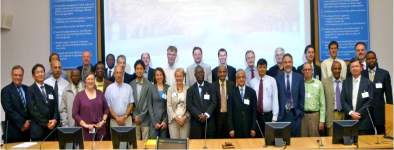GWP Executive Secretary Dr Ania Grobicki chaired the water break-out group in which it was agreed that while water supply is a sector, water is a broader, cross-cutting issue. “It was important for GWP to participate in the meeting as the overall goal of linking climate information with users at regional, national and local levels is central to GWP’s operational strategy on climate change and a key area to be addressed in the capacity building component of the GWP-AMCOW Water, Climate and Development programme,” said Grobicki.
“GWP is also in a good position to facilitate the development of working relationships between AMCOW and AMCOMET (the African Ministers Council on Meteorology), and making this link would be an important contribution to the GFCS/UIP in Africa,” Grobicki added.
The 3rd World Climate Conference in September 2009 decided to establish a Global Framework for Climate Services, as an international framework to guide the development of climate services. The GFCS is envisaged as a “set of international arrangements that will coordinate global activities and build on existing efforts in order to provide climate services that are truly focused on meeting users’ needs, are available to those who need them and provide the greatest benefits possible from knowledge about the climate”.
The High Level Taskforce (HLT) in its report on the implementation of the GFCS urged that efforts must be made to develop dialogues between providers and users of climate information and to focus on developing and implementing measures of the Framework’s success in meeting needs, and using these monitoring results to continuously evaluate and improve the overall performance of the Framework. The HLT has recommended that by the of end 2017 access to improved climate services should be facilitated globally in four priority sectors (agriculture, disaster risk reduction, health and water) and that active technical committees be established for each component as well as an active communications programme.
“The GWP network, through its Regional and Country Water Partnerships and extensive network of Partner organisations, are well placed to be one element of the UIP, bringing different sectors and different stakeholders together and facilitating dialogues and knowledge and information sharing,” said Grobicki.
“This idea was very well received by the meeting,” Grobicki continued, “who recognised that GWP is ‘an excellent partnership model to learn from’.” In-depth discussions were possible during the group session, where it was recommended to “consider using the Water, Climate and Development Programme for Africa [WACDEP] as a component and a model for further development of a UIP for Africa”. As the WACDEP is most advanced in Africa, this is where initial efforts should focus through, as a first step, linking the Regional Water Partnerships with the Regional Climate Centres.
Summary of key points from the discussions:
• The UIP is expected to provide feedback channels and to help develop a strategy to monitor the implementation and effectiveness of the GFCS
• The HLT recommended the development of Regional Climate Centres (RCCs) as a primary goal to assist developing countries while the longer term capacity is developed at national scales
• Services must be designed in consultation with users; interface should also happen at local level
• The GFCS and UIP must be built on existing mechanisms and tune to the emerging needs
• Stakeholder mapping would be a good way to identify certain core categories of users, each with different needs
• The information, products and messages provided by the GFCS should be useful from the end-users perspectives: if users need something that is not possible yet, the GFCS needs to work towards the research necessary to develop the required skills and tools, while communicating more effectively on how to use what is available for better outcomes
• National frameworks and collaboration across the various players will be needed (governments, climate users such as farmers, NGOs, academia, etc.)

